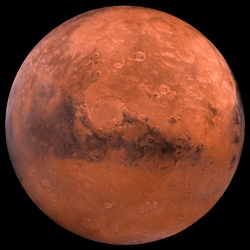
The Planetary Science Vision 2050 Workshop is happening right now at NASA headquarters. The workshop is meant to discuss space projects that could be realized, or at least started, by 2050. One of the most enticing ideas came this morning from Jim Green, NASA’s Planetary Science Division Director.
In a talk titled, "A Future Mars Environment for Science and Exploration," Green discussed launching a "magnetic shield" to a stable orbit between Mars and the sun, called Mars L1, to shield the planet from high-energy solar particles. The shield structure would consist of a large dipole, a closed electric circuit powerful enough to generate an artificial magnetic field.
Such a shield could leave Mars in the relatively protected magnetotail of the magnetic field created by the object, allowing the Red Planet to slowly restore its atmosphere. About 90 percent of Mars’s atmosphere was stripped away by solar particles in the lifetime of the planet, which was likely temperate and had surface water about 3.5 billion years ago.
According to simulation models, such a shield could help Mars achieve half the atmospheric pressure of Earth in a matter of years. With protection from solar winds, frozen CO2 at Mars’s polar ice caps would start to sublimate, or turn directly into gas from a solid. The greenhouse effect would start to fill Mars’s thin atmosphere and heat the planet, mainly at the equator, at which point the vast stores of ice under the poles would melt and flood the world with liquid water.
"Perhaps one-seventh of the ancient ocean could return to Mars," said Green.
This is some truly futuristic stuff, reminiscent of Kim Stanley Robinson’s Red Mars trilogy. But it is theoretically possible, and it just might, maybe, be a step toward terraforming Mars for human inhabitation in the next century.
